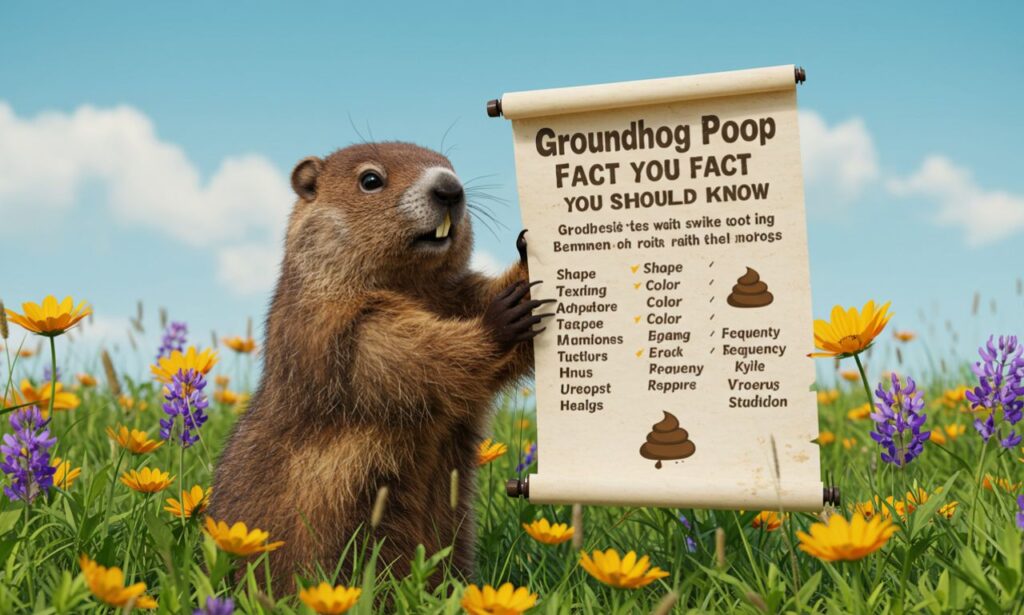Identifying and understanding groundhog poop might not top your list of favorite outdoor activities, but it’s essential knowledge for homeowners, gardeners, and wildlife enthusiasts. From protecting crops to preventing health risks, learning the details about groundhog droppings gives you a surprising edge in managing wildlife activity around your property.
Groundhog Poop: What Does It Look Like?
Groundhog poop resembles small, oval pellets, somewhat similar to rabbit droppings but slightly larger. It’s typically dark brown or black and found in clusters. Unlike some rodents or herbivores, groundhogs tend to defecate in specific areas, often away from their main burrow. This behavior distinguishes their waste from more scattered types like deer or raccoons.
These droppings are usually:
-
About ½ to ¾ inch in length
-
Slightly curved or oval-shaped
-
Moist when fresh, dry and brittle when old
-
Found in secluded corners of a lawn, near a woodpile, or by a fence
Why Groundhog Poop Matters
While it may not seem like much, groundhog poop can tell you a lot about wildlife activity on your land. Their droppings serve as a warning sign for potential burrow networks or tunnels that might be weakening your foundation or garden soil. Additionally, groundhog feces may harbor bacteria and parasites harmful to pets and humans.
Is Groundhog Poop Dangerous?
Yes, in specific contexts. Like all wild animal feces, groundhog poop can pose health risks. It can carry:
-
Salmonella
-
Leptospirosis
-
Giardia
-
Roundworms or tapeworm eggs
If pets or children come into contact with it, the results can range from mild stomach upset to severe infections. Therefore, always wear gloves when cleaning droppings, and wash hands thoroughly afterward.
Where Do Groundhogs Usually Poop?
Groundhogs are surprisingly clean animals for burrowing rodents. They typically choose specific latrine areas either inside side chambers of their burrows or at a short distance away. It’s rare to find groundhog poop in high-traffic or open areas unless the animal has been foraging heavily nearby.
You might find their feces:
-
Near deck supports or garden beds
-
Along fence lines
-
Near the entrance or exit holes of burrows
-
Under sheds or porches
Groundhog Droppings and Lawn Damage
You may think droppings themselves don’t do much harm, but in fact, groundhogs’ presence—including where they defecate—can spell trouble for your lawn. Their feces and urine can damage grass and soil pH. Even worse, their underground burrows can collapse or destabilize garden beds.
How to Clean Up Groundhog Feces Safely
If you find groundhog droppings, don’t grab a rake and dive in. First, gather supplies:
-
Gloves (disposable or thick work gloves)
-
Face mask
-
Disposable bags
-
Mild bleach or disinfectant solution
Steps:
-
Put on gloves and mask.
-
Scoop feces using a plastic shovel or scoop.
-
Bag the waste in sealable plastic bags.
-
Spray the area with disinfectant.
-
Wash hands and disinfect tools after cleanup.
Never compost or reuse groundhog waste—doing so can spread harmful parasites into your garden.
Signs of Groundhog Activity Beyond Poop
Groundhog droppings are often the first clue. Look for other signs to confirm their presence:
-
Freshly dug holes or tunnels
-
Chewed garden vegetables
-
Gnawed wood or siding
-
Footprints (four toes on front feet, five on back)
-
Discarded plant roots
If you’ve spotted poop, chances are they’ve been living nearby for a while.
What to Do if You Find Groundhog Poop in Your Yard
Don’t panic. Follow this checklist:
-
Clean up droppings using safety gear
-
Locate nearby burrows or tunnels
-
Look for signs of garden or structural damage
-
Consider setting traps or calling wildlife control
-
Secure attractants like compost, vegetables, and pet food
Prevention is key. Close burrow holes with gravel and wire mesh. Trim vegetation to limit hiding spots.
Groundhog Poop and Disease Transmission
Although not as dangerous as raccoons or bats, groundhogs can still spread disease. Bacteria and parasites in their droppings may become airborne during cleaning. This makes respiratory protection a smart precaution. Keep children and pets away from latrine sites until cleaned thoroughly.
Are Groundhog Droppings Harmful to Pets?
Absolutely. Dogs in particular might sniff, lick, or even eat groundhog feces. This can lead to:
-
Parasite infections (worms, giardia)
-
Digestive upset
-
Behavioral changes
If your pet has contact with groundhog poop, consult a vet and watch for symptoms like vomiting or diarrhea.
Seasonal Patterns of Groundhog Poop
Groundhog poop patterns change with the seasons:
-
Spring: High activity, fresh droppings, new burrow digging
-
Summer: Stable latrine areas, often hidden
-
Fall: Increased foraging, more visible poop
-
Winter: Dormant—little to no new poop
Understanding these patterns helps in timing your prevention efforts.
What Attracts Groundhogs to Poop in Your Yard?
-
Untouched compost or fruit scraps
-
Dense vegetation or brush
-
Easy access under decks or sheds
-
Unattended gardens
By managing attractants, you reduce the chances of hosting groundhog visitors—and their droppings.
Can Groundhog Poop Be Used as Fertilizer?
Despite being herbivores, groundhog feces are not recommended for fertilizing crops. Potential pathogens and parasites outweigh any benefits. Always dispose of them securely and never introduce them to compost bins.
Preventing Groundhog Poop: Effective Tips
-
Install fencing around gardens
-
Keep lawns trimmed and brush cleared
-
Seal burrow holes with mesh
-
Use repellents like ammonia-soaked rags
-
Introduce motion sensors or sprinklers
Prevention not only stops poop problems but protects your plants and structures too.
Using Scent and Sound to Deter Groundhogs
These animals dislike strong smells like garlic, vinegar, or predator urine. Strategically placing these scents near latrine areas may drive them away. Likewise, loud sounds—radios, wind chimes, or ultrasonic devices—may disrupt their sense of safety.
When to Call Wildlife Control for Groundhog Poop Issues
If you notice:
-
Regular fresh droppings
-
Multiple burrows
-
Garden devastation
-
Structural risks
Then it’s time to involve professionals. Humane trapping and relocation are typically the safest, most effective options.
Groundhog Poop Around Urban and Suburban Homes
As urban areas expand into rural zones, wildlife encounters become more common. Suburban homes with garden patches, wood decks, or open crawlspaces often find groundhog activity increasing—along with their droppings.
Conclusion
Groundhog poop may not be the most glamorous topic, but it’s incredibly telling. These small pellets offer clues to wildlife behavior, health risks, and property threats. By understanding what groundhog droppings look like, where they appear, and how to manage them safely, you can protect your home and yard effectively. From disease prevention to garden preservation, knowledge truly is your best tool.







